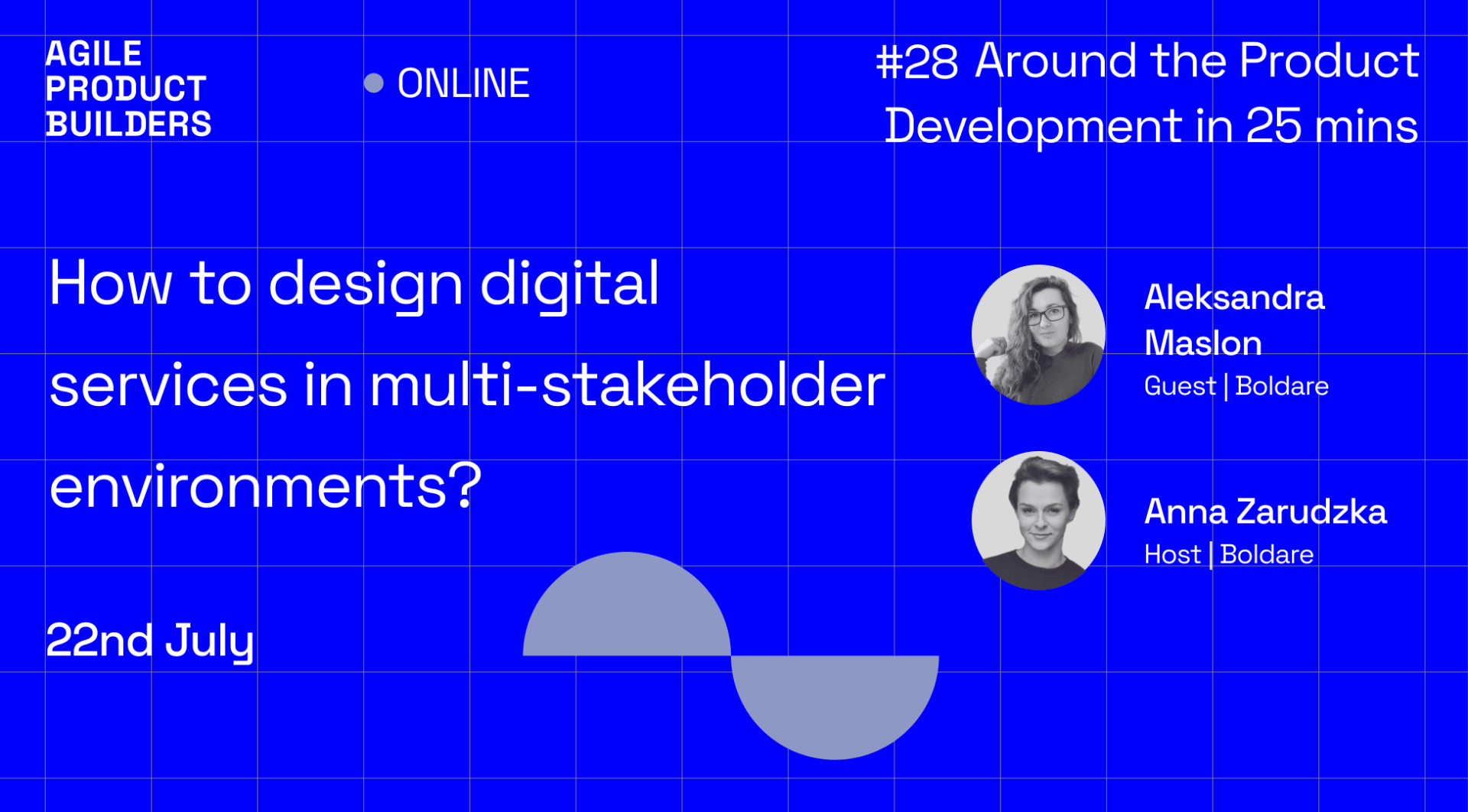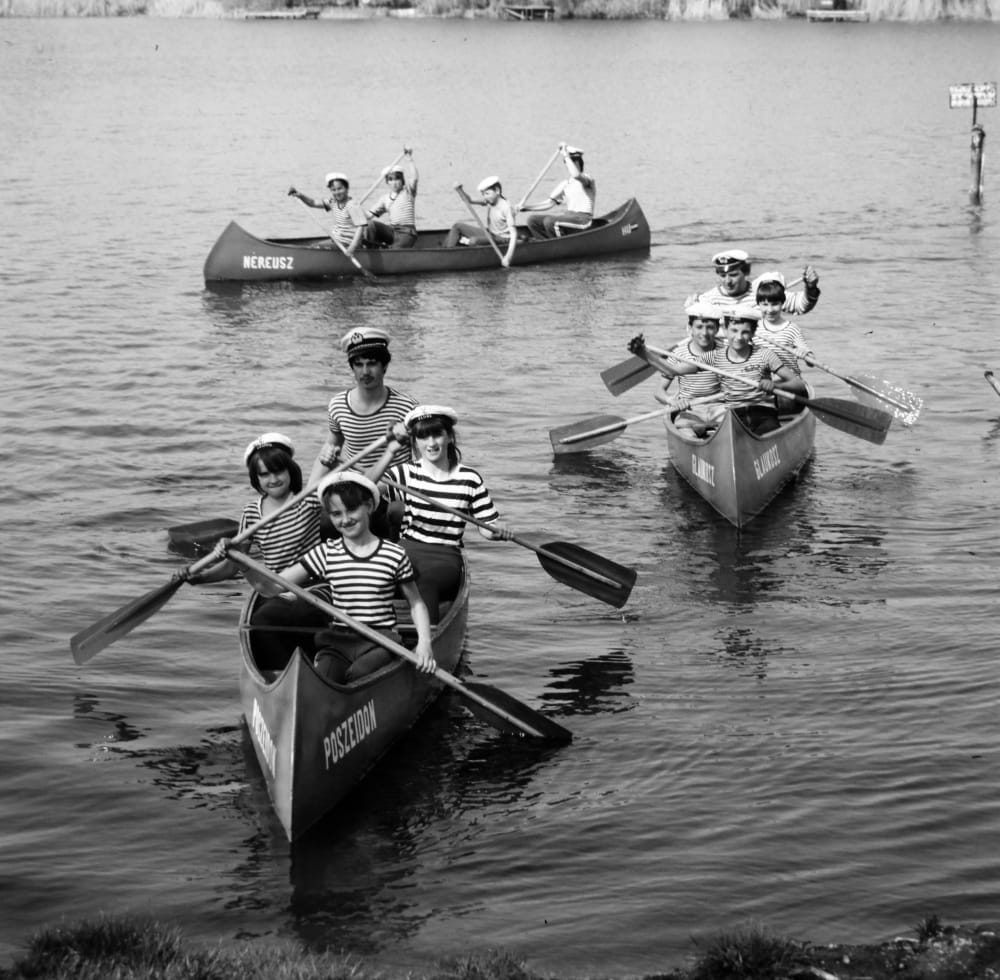Designing digital services in multi-stakeholder environments: Insights from Aleksandra Maslon
Designing digital services in environments with multiple stakeholders, each with competing interests, is a complex challenge. Aleksandra Maslon, a product designer and UX strategist at Boldare, shares her experiences navigating this complexity, particularly in her work on a Saudi government platform. This conversation offers insights on overcoming these challenges while maintaining a user-centered focus.
If you’re interested in understanding how to manage such complexity and design digital products that meet diverse stakeholder needs, we invite you to watch the episode or read the full transcript below.
Table of contents
Introduction: Setting the scene
Anna (Host): Welcome everyone to our Agile Product Builders Community webinar. Today’s session is part of our product series where we explore the complexities of building digital products in real-life contexts. And I’m Anna, and I will be your host today. Our topic is how to design digital services in multi-stakeholder environments—a space where designing digital services means aligning diverse stakeholders, often with competing mandates, while still keeping the user in focus. And I’m really happy today because I’m joined by Aleksandra Maslon, product designer and UX strategist at Boldare, a digital product company with deep experience in building products across complex multi-stakeholder environments.
For the past two years, Aleksandra has played a key role in designing and optimizing the user experience of a Saudi government platform that brings together investors, service providers, and public institutions. She also brings prior experience in research, user testing, and UX design for medical products. Her work gives her a broad perspective on how organizational, legal, and political factors influence product development. Aleksandra, it’s great to have you with us today.
Aleksandra (Guest): Thank you very much. I’m also really happy to be here with you speaking about this topic, and hopefully, everyone joining us today will get really important information that we can focus on.
The biggest challenges in multi-stakeholder environments
Anna: Let’s start with a fundamental question: What are the biggest challenges in designing digital services and products in environments where multiple government bodies and private stakeholders are involved?
Aleksandra: It’s maybe the fundamental question, but I think it’s the most important one. Why? Because the biggest challenge, in my opinion, is definitely cost coordination—both for technical reasons and cultural reasons, but still, it’s the communication and coordination in it.
Service design plays a crucial role in bridging the gaps between different points in the product design process. For example, one common challenge is the lack of alignment among stakeholders. Different institutions often have a totally different view of the product, different priorities, and sometimes even different processes they want to work with.
Different stakeholders and institutions have totally different views of the product, different priorities, and sometimes even different processes they want to work with
Another challenge we often face is fragmented systems, which lead to data silos. When thinking about different institutions, each one has its own system for storing and providing data. Bringing all of this together for a smooth flow of data is really difficult. So, we always need to consider this when starting to work on such a project.
Coordination and decision-making challenges
Anna: That sounds complicated, especially when dealing with multiple systems and priorities.
Aleksandra: Yes, it is. Another challenge I’d mention is decision-making. When we think about multi-stakeholder environments, getting easy approvals can be difficult. Multiple stakeholders have different layers of approvals, different responsibilities, and sometimes their approach to risk management is entirely different, which we need to take into account in the process.
This complexity can slow down not only design but also the entire delivery process.
Anna: So, it seems like coordinating various levels of approval can be a real bottleneck in these environments.
Aleksandra: Exactly. And also, when we talk about ownership, who takes responsibility for each step of the process is another challenge. When we work in a multi-stakeholder environment, we need to define who is responsible for what part of the process, especially when it comes to implementation and moving forward. In addition to all these, we also face political and policy barriers that can be specific to the industry or institution involved.
How consulting and tech partners can help
Anna: Many companies seek help from consultants or tech partners. How can a consulting or tech partner effectively support a client navigating legal, political, and organizational constraints?
Aleksandra: The key thing here is to understand that we’re not just delivering solutions. We’re guiding our clients through the entire process. Our role is not just to provide the product but to be a trusted guide in navigating the complexities of these environments.
One of the ways we support our clients is by mapping the constraints they face and creating a strategy around them. We need to help our clients understand the political landscape, the policies involved, and how these influence product development.
We also facilitate cross-stakeholder collaboration by organizing workshops or strategy sessions to bring everyone on the same page and align them with the product goals.
We need to act not just as a vendor, but as a trusted guide, demonstrating our ability to understand the political and policy context
Aligning stakeholders with artifacts
Anna: What kinds of tools or artifacts have you found most useful for creating alignment among stakeholders with conflicting priorities?
Aleksandra: When working in multi-stakeholder environments, it’s not just about the documents. The tools should shape the communication and align teams. Starting with a vision statement for each stakeholder group helps clarify their expectations. We then bring these visions together into a product roadmap. A stakeholder map can also be helpful for understanding roles and relationships among the various stakeholders, especially in large groups. User personas are also critical when dealing with complex products serving different user groups.
The role of a product owner
Anna: A proper product owner seems essential for managing all of this complexity. How important is the role of the product owner?
Aleksandra: Yes, a strong product owner is crucial. Even if they need to seek approvals from others, they must take responsibility for decision-making. Having one person overseeing the entire process ensures that things move forward, even when complications arise.
The design system as an alignment tool
Anna: Is a design system helpful for alignment between stakeholders?
Aleksandra: Yes, a well-prepared design system is essential. It provides options and bridges the gap between different priorities. A good design system allows stakeholders to focus on the shared product strategy and common goals.
Final advice for product leaders
Anna: Finally, what piece of advice would you give to someone stepping into product leadership in a multi-stakeholder environment for the first time?
Aleksandra: Don’t rush. It’s not possible to have all the answers at the start. The most important thing is to focus on building trust and establishing a shared understanding of the process. The answers will come as you go through the process. Focus on the most critical aspects first, and everything else will fall into place.
Focus on the most important things first, and everything else will fall into place
Conclusion: Key takeaways for designing in multi-stakeholder environments
Designing digital services in environments where multiple stakeholders are involved requires a balance of communication, coordination, and careful planning. Key insights from Aleksandra Maslon’s experience emphasize the importance of alignment, trust, and a strong product ownership model to navigate the complexities of multi-stakeholder projects. Some key takeaways include:
- Stakeholder alignment is crucial for successful project execution.
- Data silos and fragmented systems must be addressed early on to ensure smooth information flow.
- Decision-making can be a bottleneck, but clear ownership and responsibility can help speed up the process.
- A design system and artifacts like stakeholder maps and user personas help align goals and expectations.
- A product owner who can guide the process and make critical decisions is vital.
By focusing on these core principles, product teams can better navigate the challenges of working in multi-stakeholder environments and create digital services that meet both user needs and stakeholder priorities.

Share this article:






